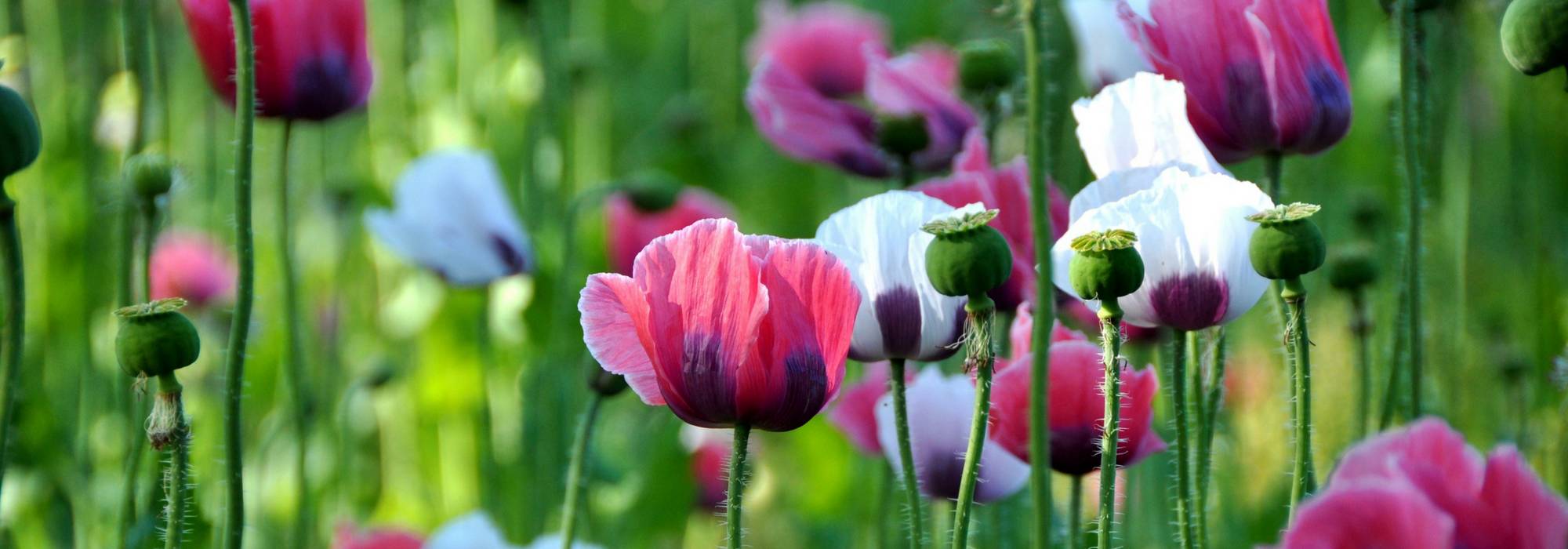
Poppies and annual poppies: sowing, growing and care
Contents
Annual poppies in a nutshell
- Annual poppies brighten gardens with their lavish colours from May to July
- Their fruits are stunning in dried bouquets
- Easy to grow, they shoot up quickly and thrive in the sun, in well-drained soil
- To our delight, they self-seed spontaneously in the most unexpected places!
- There is a very wide choice of colours and shapes
A word from our expert
Annual poppies are undoubtedly among our easiest wild plants to use. Hardy, they require only minimal maintenance. Growing quickly, they produce a dazzling floral display for a season. Their rounded corollas with silky, crumpled petals can showcase all colours and shapes. After flowering, their decorative fruits will scatter countless seeds in the wind. Mischievous and unpredictable, they then invade the most unlikely corners of the garden.
Whether they are cornflowers, garden poppies, or California poppies, they thrive in the sun and in well-drained, even poor soil. Very hardy, they can withstand temperatures down to -25°C depending on the variety and are not very demanding.
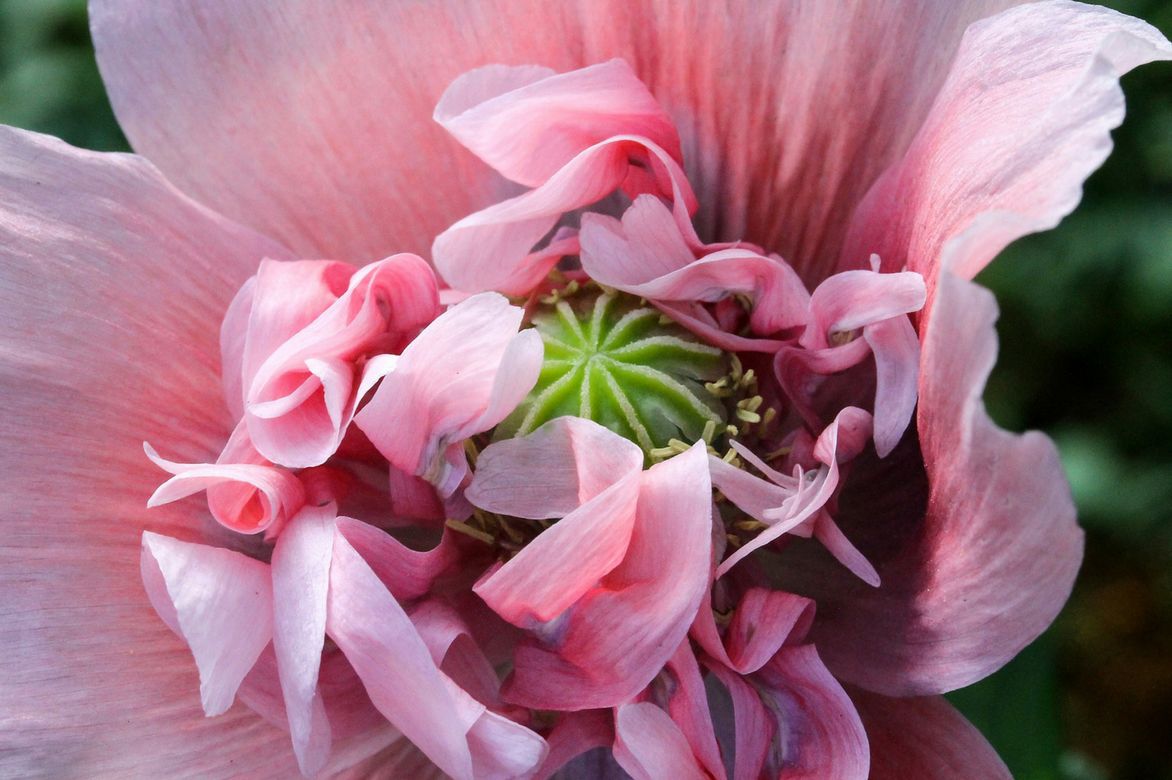
Fluffy heart of a opium poppy.
Annual poppies are valuable for the gardener as they provide a colourful transition between spring and mid-summer blooms. They effectively fill seasonal gaps in borders, as well as slightly neglected areas of the garden. Especially since the choice is vast: pink or white cornflowers, peony-flowered poppies for a romantic corner, poppies with multiple petals more or less undulating forming plump pom-poms, frayed corollas, bicoloured ones…
Poppies have their place everywhere: in natural gardens or flowering meadows, of course, where they mix amiably with grasses and other annuals, but they also invite themselves into urban or classic gardens, where they cheerfully brighten the space. Their simple flowers will bring freshness and a natural touch to a contemporary garden and they will whimsically occupy slopes or open spaces in the garden.
Botany
Botanical data
- Latin name Papaver
- Family Papaveraceae
- Common name annual poppy, garden poppy, corn poppies
- Flowering May-July
- Height 0.70 m to 1.20 m
- Exposure sun
- Soil type deep and drained
- Hardiness -30°C
The Papaveraceae are mostly herbaceous plants native to the temperate northern hemisphere. European and American poppies have each evolved differently, resulting in distinct genera. It is primarily the variations in floral parts that classify poppies into different genera: for example, the shape of the pistil, whether petals are fused or not… but this is not really obvious to the layperson! In fact, poppies are instantly recognisable by their large flowers with bright colours and silky, crumpled petals.
The decorative leaves are simple and highly dissected, with a bluish-green colour. The typical flowers are solitary with free sepals that quickly wither. They feature 4 to 6 petals and numerous stamens. The stem is unbranched. Poppies have a taproot, the main axis that penetrates deeply into the soil from which tiny rootlets emerge. This root is easy to break during transplanting, which is why it is better to plant them directly in place.
The sap of the Papaveraceae contains latex composed mainly of alkaloids such as papaverine or morphine. White poppies (Papaver somniferum album) are cultivated for their production of opium for pharmaceutical uses. This cultivation is strictly regulated by law. The black poppy (Papaver somniferum nigrum) does not contain such active narcotic substances, and as a result, this variety is widely used to beautify our gardens.
Generous, simple, and low-maintenance, poppies can easily vegetate in difficult spots such as slopes, flowering the front of a hedge or neglected areas of the garden. They also have their place in borders: flowers with more sophisticated shapes and colours pair wonderfully with other perennials or roses. They persist in their own way, self-seeding wherever they please… The surprise of not knowing what the seeds will produce and where they will reseed is part of the joy of growing poppies.

Papaver somniferum – botanical illustration
Annual poppies encompass several species from the Papaveraceae family, including the following main ones:
- Papaver rhoeas, the famous corn poppy
- Papaver somniferum: garden poppy or opium poppy
- Eschscholzia californica, a different genus but from the same family as our poppies. This is the California poppy.
The corn poppies
Papaver rhoeas or corn poppy, a messicolous flower, has become the emblem of flowering and natural meadows. It is the hairy one in the family: its stems and flower buds are covered in hairs. We love the lovely contrast between its bright red and the surrounding green vegetation. Today, there are many varieties, notably those from the “Shirley” group, named after the British botanist William Wilks (1843-1923). Thanks to his long and patient work of selections and successive cross-breeding, we can cultivate poppies in pastel colours, both single and double. With their unusual colours, pink or white poppies are sure to catch everyone’s eye. If you prefer bright colours, you might choose the cultivar Ladybird (ladybug), aptly named, spectacular with its vermilion colour and black spots!

Poppies or Papaver rhoeas can be of several colours.
The garden poppies
Papaver somniferum or garden poppy has larger flowers than its cousin the corn poppy. Its foliage is less branched, and the robust, hollow stem is glabrous and taller (from 1 m to 1.5 m!). For the gardener, the choice is endless as there is a very wide range of shapes and colours. The petals can be single or multiple, creating peony-flowered varieties (like the Black Peony annual poppy) or resembling carnations (like the bicolour Berries & Cream) and the extraordinary fringed pompom varieties proudly displayed by the cultivar Tallulah Belle Blush… The shapes of the petals can be rounded or frayed, like the graceful Pink Fizz, and all colours are represented except blue.
After the exuberant or simple corollas, the fruits continue the display in a more subtle and delicate manner. The ornamental capsules, with subtle and changing colours in the light, can remain in the garden long after flowering, thus showcasing graceful and ephemeral plant sculptures.

From the simplest to the very double, the opium poppies come in many colours.
The California poppies
Eschscholzia californica or California poppies, are the American cousins of our poppies. Smaller, they form rounded, spreading tufts with beautiful, finely divided, feathery bluish-green foliage. Their cup-shaped corollas with 4 petals are bright orange for the typical species, but many cultivars enrich the “collection,” with colours ranging from cream white to red, and petals that are more or less double. Moreover, they bloom for a longer period and can become perennial in mild climates. Their difference from European poppies also lies in the fruits: they are long, tapered capsules that open completely to project their countless tiny seeds.
Here too, California poppies will be used to fill empty spaces in the garden. They bring splashes of colour alongside thymes, lavenders for example, either in contrast or in shades with mauve and pink cultivars… These flowering cushions will work wonders at the border and they can colonise slopes with flair, for the wild orange variety, or elegance with the cream-white varieties.
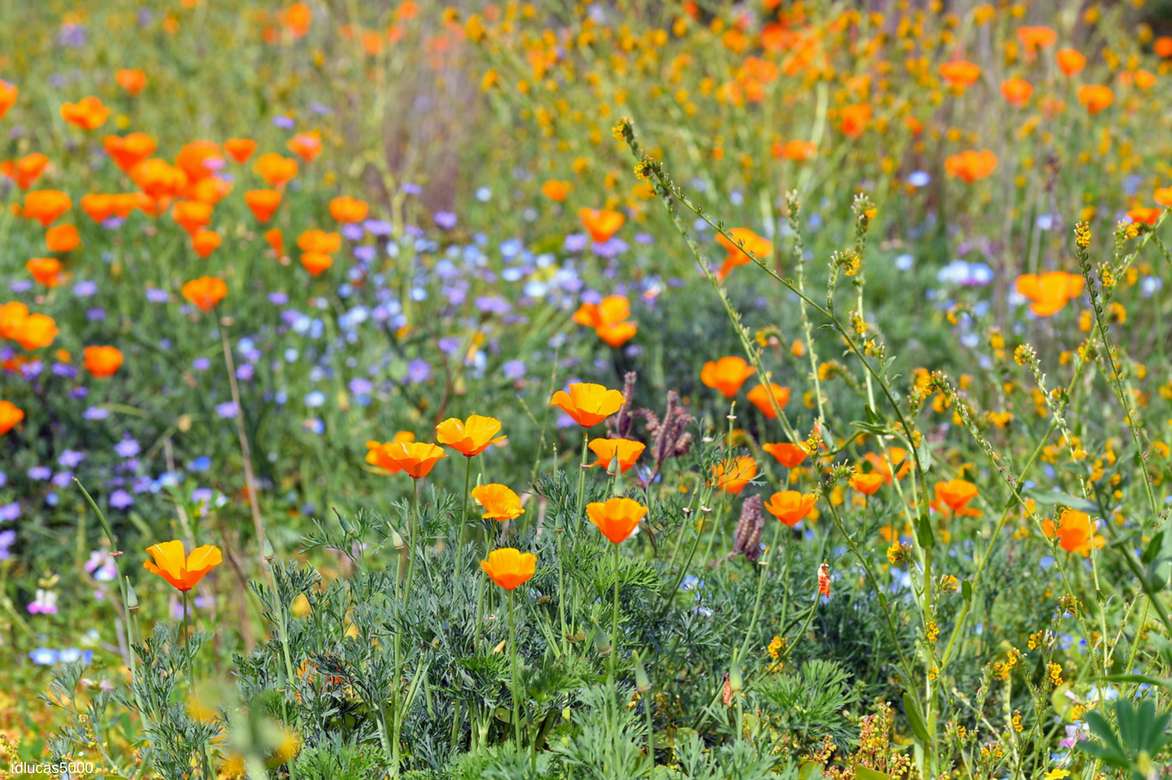
Over the years, the California poppy self-seeds to form lovely flowering expanses with a natural look.
Read also
Oriental poppies: how to grow themThe main varieties of poppies
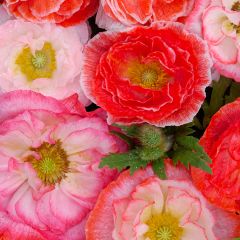
Poppy Falling in Love mix Seeds - Papaver rhoeas
- Flowering time July to September
- Height at maturity 80 cm
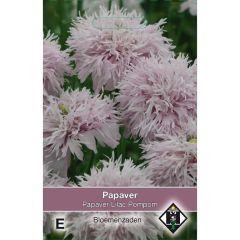
Papaver paeoniflorum Lilac Pompom
- Flowering time July to September
- Height at maturity 90 cm

California Poppy Bridal Bouquet Mix Seeds - Eschscholzia californica
- Flowering time July to October
- Height at maturity 25 cm
Discover other Poppy seeds
View all →Available in 1 sizes
Available in 1 sizes
Available in 1 sizes
Available in 1 sizes
Available in 1 sizes
Available in 1 sizes
Available in 1 sizes
Available in 1 sizes
Available in 1 sizes
Available in 1 sizes
Our favourite annual poppy varieties
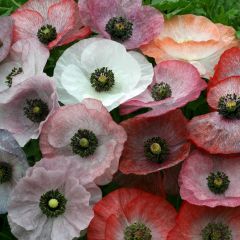
Papaver rhoeas Parelmoer
- Flowering time July to September
- Height at maturity 60 cm
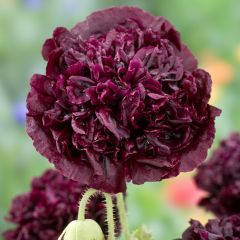
Opium Poppy Black Peony - Papaver somniferum
- Flowering time July to September
- Height at maturity 90 cm
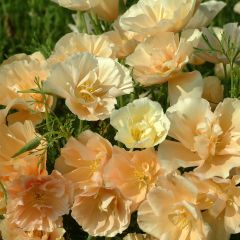
California Poppy Peach Sorbet - Eschscholzia californica seeds
- Flowering time June to October
- Height at maturity 30 cm
Varieties to Discover
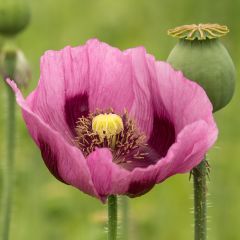
Papaver somniferum nigrum - Poppy Seeds
- Flowering time August, September
- Height at maturity 1 m
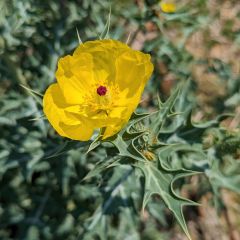
Dicranostigma franchetianum - Eastern Horned Poppy seeds
- Flowering time July to October
- Height at maturity 60 cm
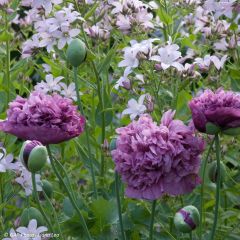
Opium Poppy Purple Peony Seeds - Papaver somniferum
- Flowering time July to September
- Height at maturity 80 cm
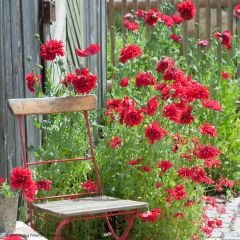
Opium Poppy Red Peony Seeds - Papaver somniferum
- Flowering time July to September
- Height at maturity 90 cm
Sowing annual poppies
Where to sow annual poppies?
Poppies thrive in sunlight, in well-drained and deep soils to allow their taproot to anchor properly. In any case, it is important to prepare the soil well before sowing.
When to sow?
Annual poppies are sown in autumn and early spring, with autumn being the ideal time. In October, the still warm soil and autumn rains allow for quick germination, giving seedlings several weeks to establish themselves. By the end of spring, the already robust plant will produce magnificent flowers.
Sowings in March will yield poppies that will flower later. Beyond April, the plants will be weak as they will not have had enough time to develop their foliage before flowering.
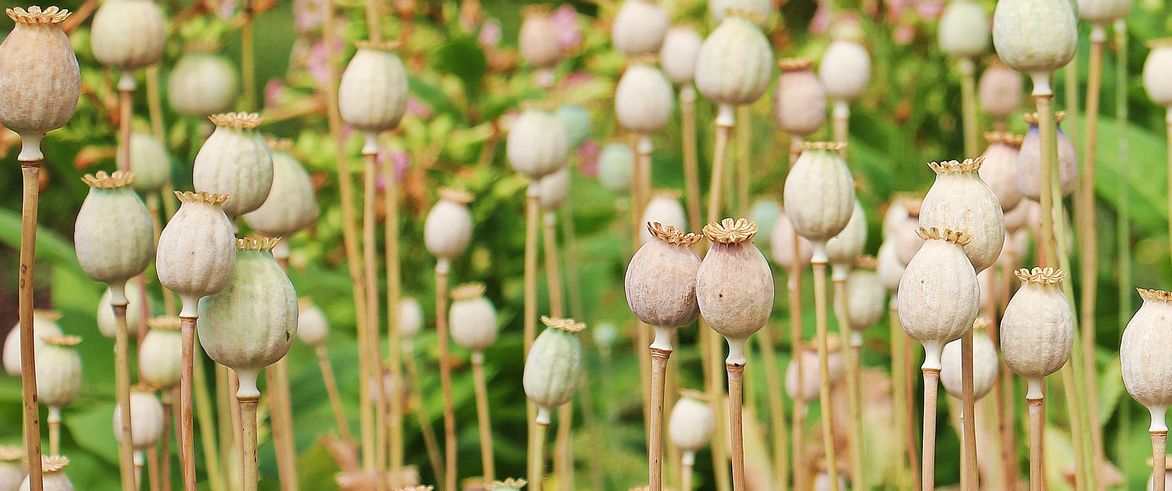
Seed capsules of Opium Poppies.
How to sow?
In open ground
Before sowing your poppies, a false sowing will help limit adventive plants. The step-by-step process for this is described in the technical sheet “False sowing, an effective technique to reduce “weeds”.
Here is a method to sow your poppy seeds:
- Weed the area where you want to plant your poppies
- Work the soil with a spade to a maximum depth of 10 cm, incorporating sand if your soil is heavy and clayey
- Break up the soil with a rake and level it to obtain a flat surface
- Sow by scattering. The seeds are tiny: for an even sowing, mix the poppy seeds with sand
- Lightly compact the soil with the back of a spade, for example, so that the seeds adhere to the soil.
- Water with a fine spray, avoiding runoff that would wash away the seeds
- Water until germination if it does not rain
Sowing poppies in pots
For a fleeting scene, poppies can be sown in pots or window boxes. In this case, choose varieties with a small growth habit, such as California poppies and cornflowers. Scatter sow in a large pot or window box and lightly compact. Thin out the plants if there are too many, and that’s it! Regular watering is essential as pots dry out quickly.
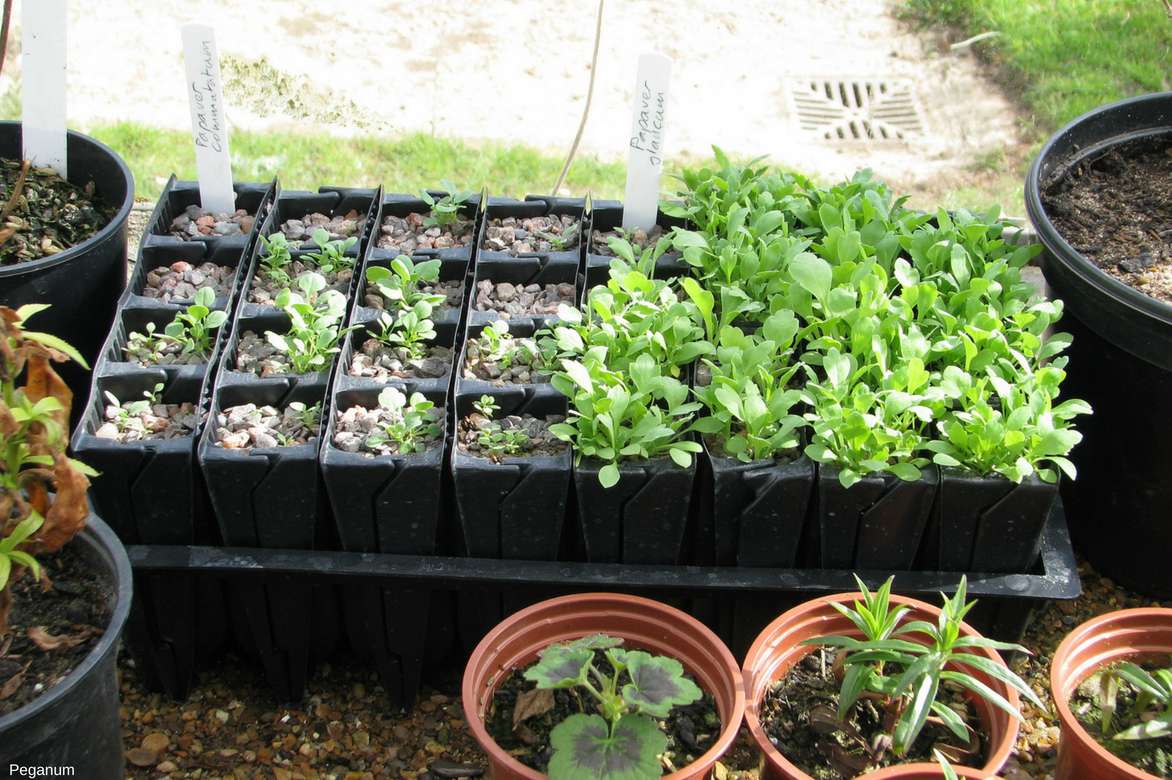 Sowing poppies.
Sowing poppies.
To learn more, discover our tutorial How to sow cornflowers?, Gwenaëlle’s tips in How to succeed with annual and perennial poppies?, as well as Virginie’s article explaining how to make a sowing of annual seeds in this article.
Care
Annual poppies are low-maintenance plants that require little care. In case of drought, watering supports the flowering. Occasional manual weeding prevents any proliferation of adventive plants. As they generously self-seed, there is a risk of them taking over the garden. A quick thinning of overcrowded young plants is possible during the autumn or the following spring. If necessary, cut the faded flowers to prevent seed formation… and create lovely bouquets!
Propagation
Annual plants, poppies propagate by sowing, simply collect the seeds when they reach ripeness. As the seeds are very fine, gently cut the stems and shake the bouquet into a paper bag. Store the seeds in a cool, dry place until the next sowing.
Also, read our tutorial How to propagate poppy?
Diseases and pests
Most annual poppies are endemic and have therefore adapted to the soil climate of our regions. However, aphids are very fond of them, and an invasion can sometimes devour our tender poppies.
As aphids are a recurring enemy, the gardener has developed several control strategies. The simplest is to provide them as prey for their natural predators, the larvae of ladybirds or hoverflies, ensuring that these little aphid-eating creatures feel at home in the garden. This means offering them places to hide, mate, and complete their life cycle peacefully, without pesticidal products, of course!
Advice on how to keep our ladybird friends close to our flowers is offered in this article by Ingrid: long live relay plants, and Virginie provides further control and prevention tips.
Associating poppies in the garden
In the garden, poppies can be used in multiple ways, to fill your flower beds, dress large temporarily empty spaces, or to enliven your borders for a year.
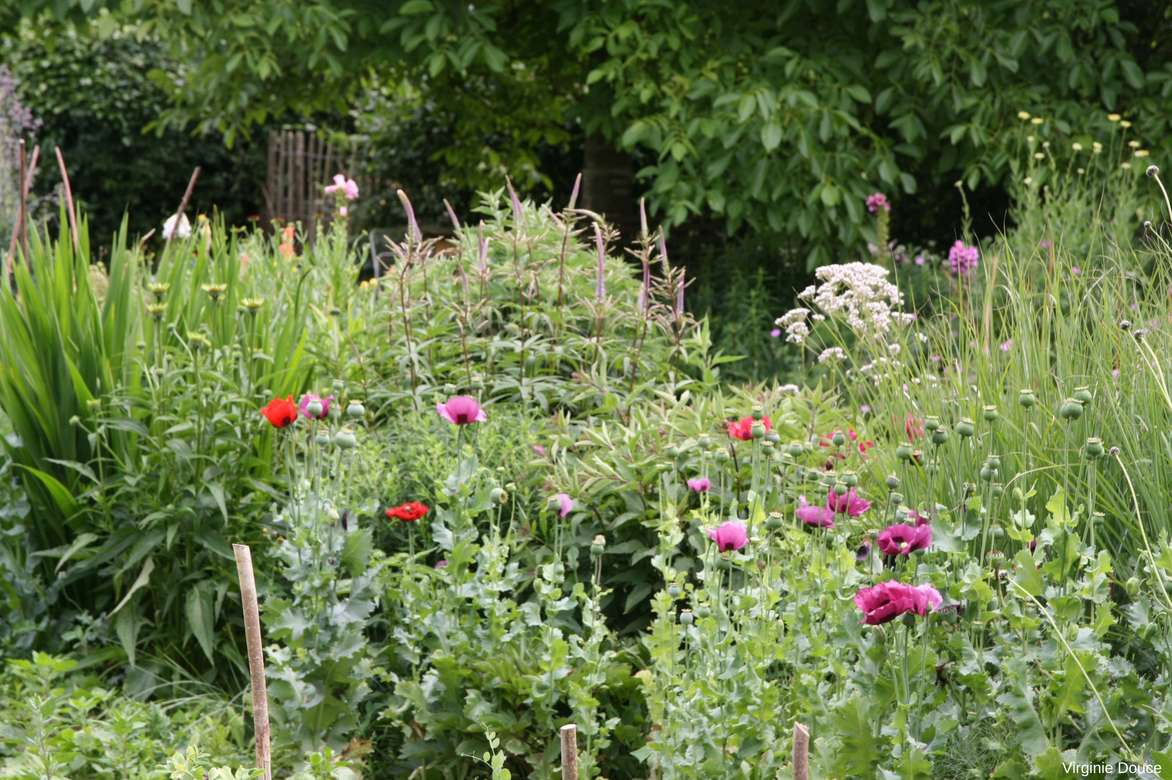
An example of a flower bed association: Various poppies including Papaver somniferum ‘Nigrum’, Veronicastrum virginicum ‘Fascination’ and Miscanthus sinensis ‘Gracillimus’ (Garden “Pumpkins and Goblin”).
Fill the base of old fruit trees with poppies: the flowering of these playful annuals will follow that of the shrubs. The poppies will fade as the fruits appear, which will then capture all the attention.
You can create flowering meadows or natural flower beds: with other annuals or mixed with perennials, you will have a changing spectacle throughout the seasons with minimal maintenance. The only limit will be your imagination!
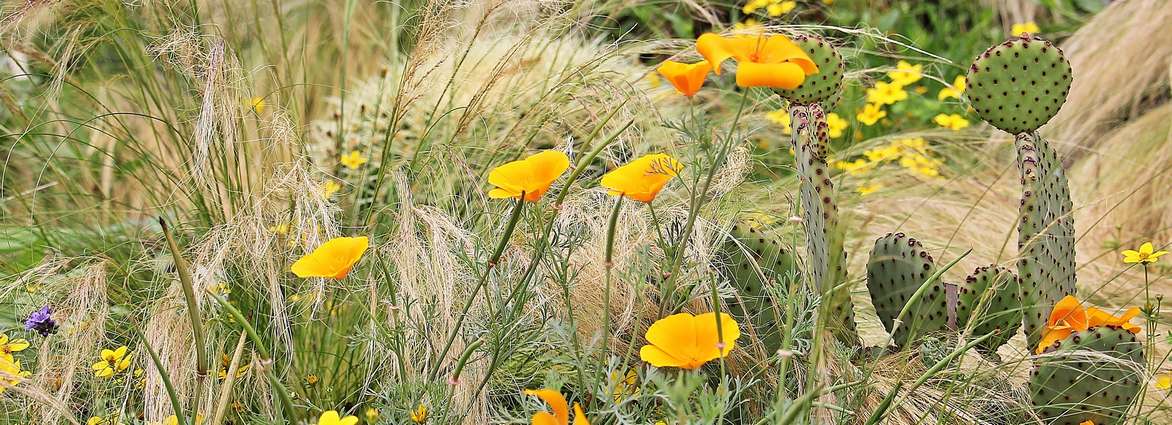
The California poppy pairs wonderfully with Stipa tenuifolia.
Poppies naturally find their place in a dry garden. Sow cornflowers or simple-flowered poppies among bushes of wormwood, convolvulus, santolina, and rosemary. Lower plants like thyme, nepeta, and erigeron also play the role of a persistent framework for the bed, and ground covers like Lippia nodiflora and Achillea crithmifolia fill the spaces. A gravel mulch will limit the germination of adventive plants. Spring bulbs that naturalise, along with self-seeding poppies, ensure a floral display from early spring to summer.
Peony-flowered poppies can adorn the base of roses. The choice of colours for each plant allows for all combinations: black or purple poppies with pale yellow or orange single roses, punctuated by the round heads of alliums, for a chic and trendy contrast. Multicoloured cornflowers with dominant pink and red will joyfully clash with white or pink roses…
Did you know?
The relaxing virtues of California poppies and poppies are used in traditional pharmacopoeia.
The poppy is also an organic indicator plant: it grows in disturbed soils with high water contrast.
The opium poppy is divided into two varieties: album and nigrum. This refers to the colour of the seeds. White seeds will produce poppies that are very rich in opium. As a result, they are not marketed. Seeds containing negligible amounts of opium are used, particularly for making curry paste.
Black poppy seeds (Papaver somniferum nigrum) are used in cooking, traditionally in Eastern Europe, to decorate and flavour breads, cheeses, or cakes. Poppy seed oil, obtained from pressing these seeds, is used as a binder in oil painting, just like linseed oil.
Useful resources
Discover all our varieties of annual poppies.
The cornflower is the champion of flower meadows… The Noé French Association describes all the benefits of installing a natural flower meadow in a corner of the garden.
- Subscribe!
- Contents
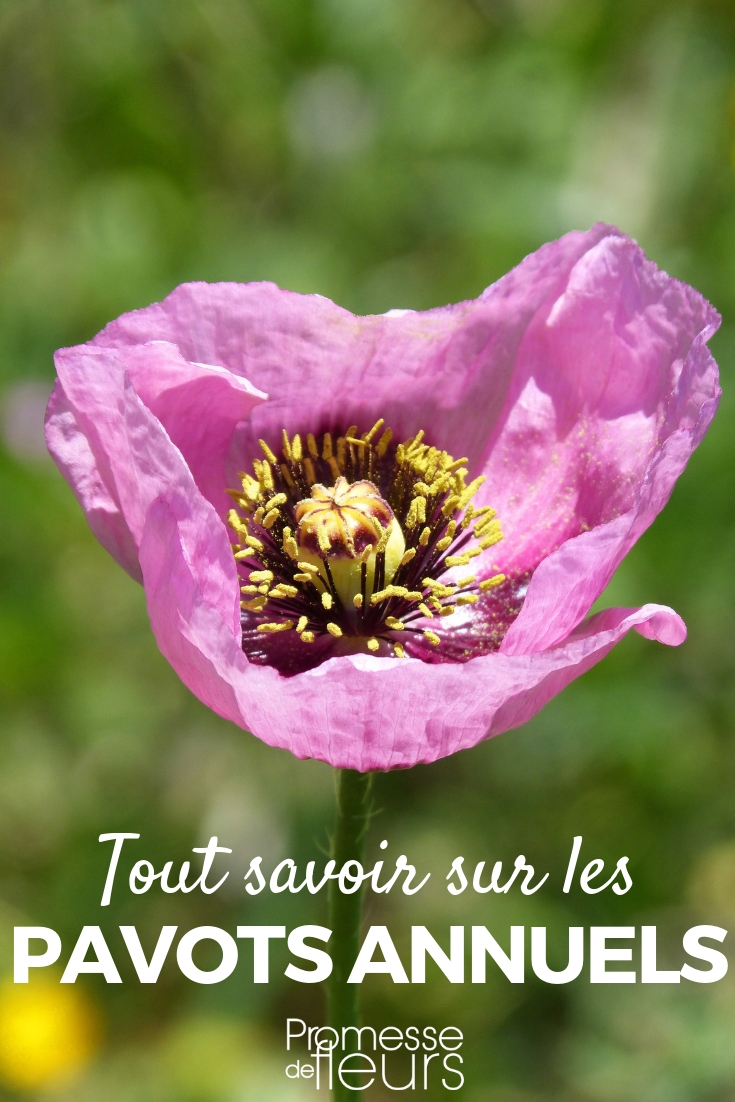































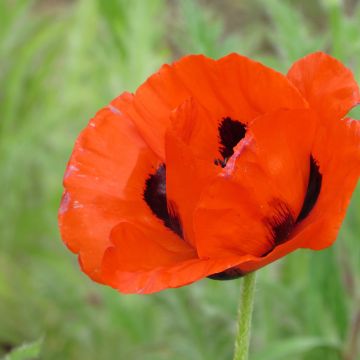

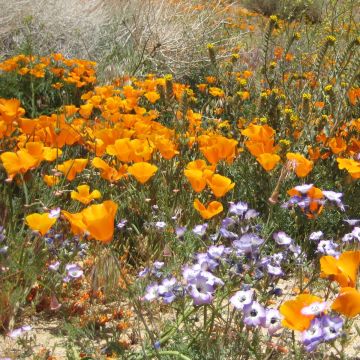

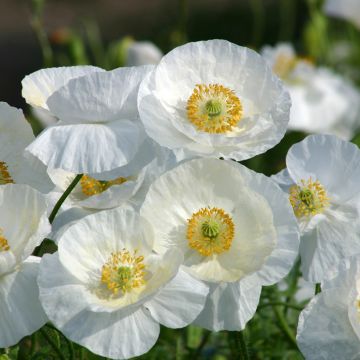
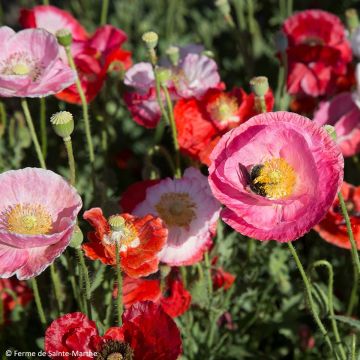
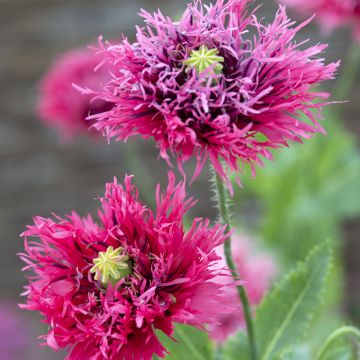



Comments